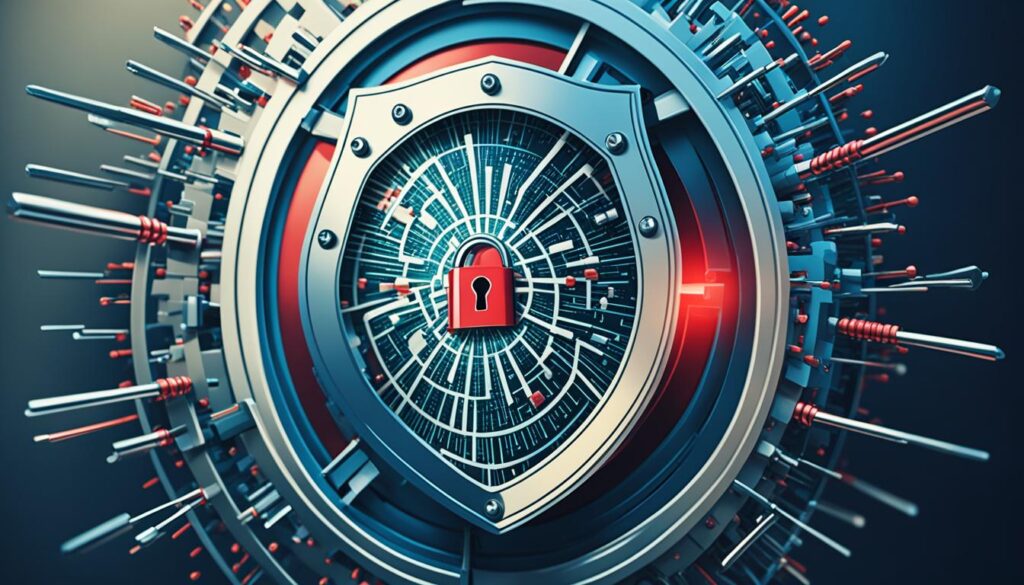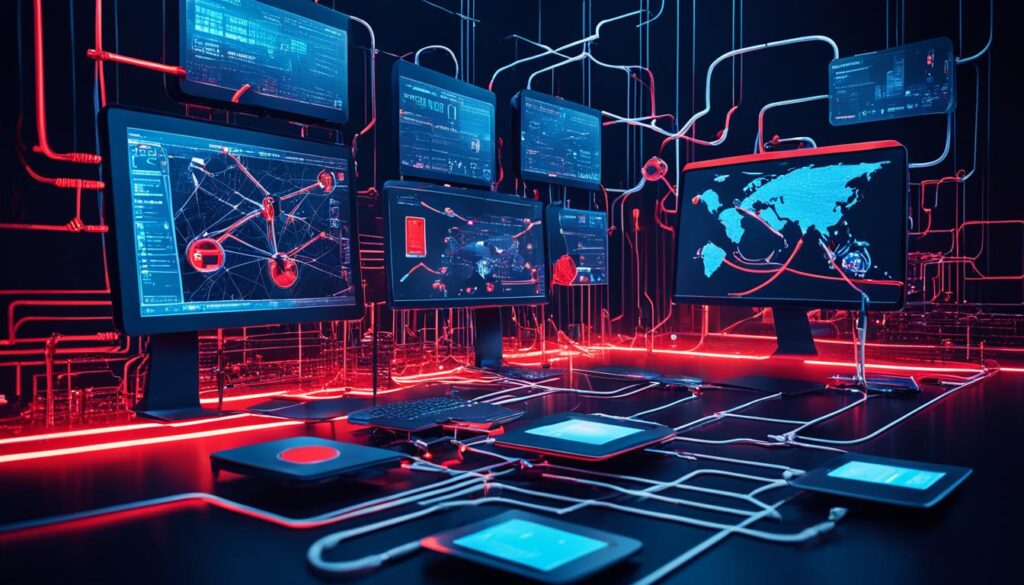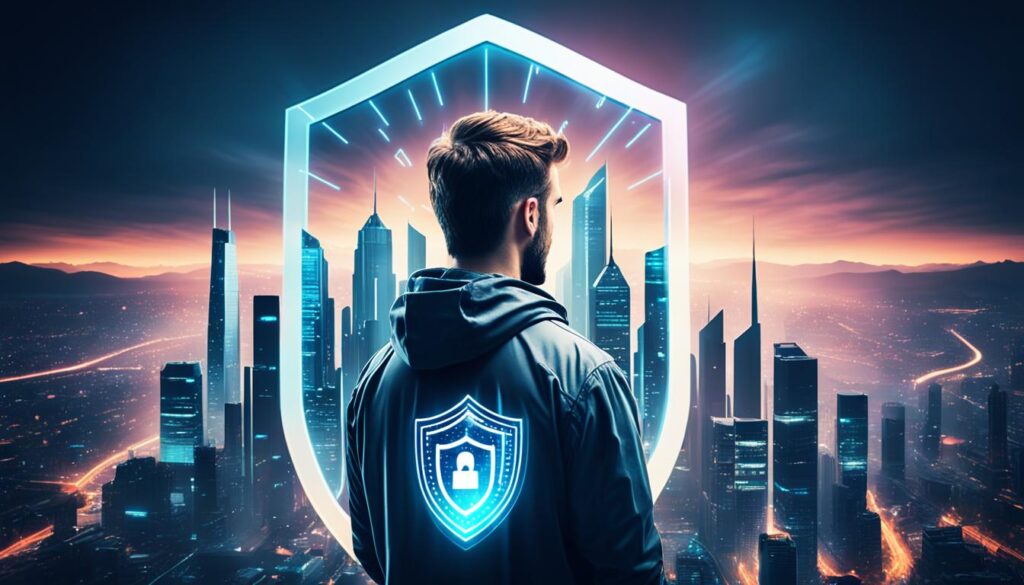Looking ahead to 2025, cybersecurity is a big deal. It affects our digital lives a lot. A recent study showed 71% of companies faced cyber issues because they lacked skilled workers1. This shows we need to get better at handling cyber threats fast.
Understanding cybersecurity trends is key. AI is changing how we fight cyber threats, making threat detection smarter1. Also, new laws will make protecting data even harder, pushing for better security rules1. These changes show how complex the future of cybersecurity will be.
Key Takeaways
- The scale of cybersecurity challenges and scope necessitates ongoing vigilance against evolving threats.
- Cybersecurity workforce shortage is an immediate and pressing concern for the safety of organizational data1.
- Innovation, particularly in AI, is critical to future cybersecurity advancements1.
- Organizations will increasingly lean on cybersecurity service providers to manage cyber risk1.
- Preparedness and prevention will become the cornerstones of cybersecurity strategy in the coming years1.
- Regulatory changes are looming, demanding enhanced safeguards for personal data1.
- The integration of cybersecurity assessments and cyber insurance policies is becoming integral to corporate security strategies1.
Understanding the Evolving Cybersecurity Landscape
The world of cybersecurity is changing fast. It’s because cyber threats are getting more complex and new tech is coming out. As more industries go digital, we need to find a balance. We must use new digital solutions and keep them safe.
Balancing Security and Innovation in the Digital Age
Security threats are always changing. Now, we see threats from countries and ransomware attacks more often2. To fight these threats, we’re using AI in cybersecurity. This includes advanced machine learning to stop threats before they start. It shows how important it is to add strong security to new tech.
Navigating Beyond Traditional Security Measures
Old security methods don’t work anymore against new threats. Things like Kubernetes and container management are especially at risk2. Companies like SUSE are helping by offering secure ways to manage containers and Kubernetes. This keeps our systems safe and in control.
The Role of AI and Machine Learning in Cybersecurity
AI and machine learning are key to today’s cybersecurity. They help us find and analyze threats better. For example, SUSE got better at protecting apps with AI2. They also keep an eye on security and act fast to stop threats, reducing damage2.
Understanding AI and machine learning is crucial for a secure future in cybersecurity. These techs help predict threats and keep up with new ones. They change how we handle and beat cyber risks.
Using the latest cybersecurity tools and strategies is key to fighting today’s risks. As we move forward, combining AI and machine learning with strong cybersecurity plans will be vital. It will shape the future of keeping our digital world safe.
The Impact of Regulatory Changes on Cybersecurity Strategy
In today’s digital world, cybersecurity regulations are changing fast. They affect how you plan your cybersecurity strategy. Laws and court decisions are making big changes. This is true for rules like GDPR and CCPA.
On June 28, the Supreme Court changed the rules. This affects all areas, including cybersecurity. It shows how old security rules might not be strong enough3.
This big change means new cybersecurity protocols must really match what Congress wanted. This could lead to more legal fights. It might make security rules different in each place3.
- The TSA made new rules for airports and planes in 2022. This shows how fast rules can change3.
- Old laws like the Health Insurance Portability and Accountability Act and the General Data Protection Regulation set the stage for today’s rules4.
- The California Consumer Privacy Act in 2020 and laws in other countries show a push for more rights for consumers4.
Businesses must quickly adjust to stay in line with the law and keep customer info safe. They need to spend more on cybersecurity experts to follow these new rules.
| Year | Regulation | Impact |
|---|---|---|
| 1996 | HIPAA | Sets the standard for protecting sensitive patient data |
| 2018 | GDPR | Enhances data protection and privacy for all individuals within the European Union |
| 2020 | CCPA | Increases privacy rights for consumers in California |
As rules get stricter and laws change, your cybersecurity plan must keep up. It should not just follow current rules but also be ready to change. This way, you can protect your business and stay in line with the law34.
Ransomware and Social Engineering: Persistent Threats into 2025

The world of 2025 faces big challenges with ransomware and social engineering. Ransomware will cause huge economic losses, about $10.5 trillion a year by 20251. Social engineering is getting smarter, using AI to make fake emails that trick people. This makes cybersecurity risks and uses cybersecurity vulnerabilitiesk5.
High-Profile Cases and Their Aftermath
Big attacks have hit big companies hard. Ransomware attacks jumped by 94% since 2022, showing how skilled and bold hackers are6. These attacks cause big money losses and make people doubt digital safety. Companies are now working harder to keep data safe.
Advancements in Phishing Tactics and Defense Strategies
Phishing has gotten much better, with hackers targeting top bosses more often5. To fight this, companies are using better email filters and more secure ways to log in5. It’s also key to teach staff to spot and report strange emails5.
Corporate and Individual Vulnerabilities
Companies and people are still easy targets for hackers. Most data breaches in 2025 will be because of mistakes by users6. This shows we need better security solutions that teach users too. Knowing about these risks is crucial for better security.
Getting ready for these threats means keeping up with the latest in cybersecurity solutions and laws. Taking steps now will protect your online stuff and personal info from future threats. Having strong security helps avoid losing money and damaging your reputation from big breaches.
| Cyber Threat | Tactics Used | Defensive Measures |
|---|---|---|
| Ransomware | Multivector attacks, use of zero-day exploits | Network segmentation, regular backup of data |
| Social Engineering | Targeted phishing, imitation | Employee education, multi-factor authentication |
| General Vulnerabilities | Misconfigurations, user errors | Regular audits, enhanced settings control |
As technology changes, so must our ways to fight cybersecurity risks. Being proactive and informed helps you stay safe in the complex world of cyber threats. Keep up, stay safe.
The Integral Role of Cybersecurity Frameworks and Vulnerability Assessments

In today’s digital world, using a strong cybersecurity framework is key. It helps keep networks safe and handle cyber threats well. The NIST Cybersecurity Framework helps organizations get better at security by fighting cyberattacks. Its latest version, from February 2024, talks about the need for good governance and safe supply chains7
As the internet grows, so do cyber threats. That’s why cybersecurity vulnerability assessments are more important than ever. They help groups like public safety find and fix system weaknesses8
Understanding what needs protection is key in a cybersecurity risk assessment. This means listing network weaknesses and keeping an eye on logs and audits of networks8
Studies show how frameworks like ISO 27001 help organizations make and follow info security plans. The CIS Control Framework also has 20 controls for things like handling incidents and managing assets. This helps different kinds of organizations get better at cybersecurity7
Following standards like SOC2 and PCI-DSS means watching over your processes closely. It also builds trust with customers by keeping payment card data safe with strict access and encryption7
| Framework | Focus Area | Key Components |
|---|---|---|
| NIST Cybersecurity Framework | General | Identify, Protect, Detect, Respond, Recover |
| ISO 27001/27002 | Information Security | Comprehensive Data Protection Standards |
| CIS Control Framework | Operational | Basic, Foundational, Organizational Controls |
| HITRUST | Healthcare | Patient Data Security |
To get better at cybersecurity, agencies suggest using tools like the Cyber Security Evaluation Tool (CSET). It helps find and fix weaknesses in networks or systems8
Using these frameworks helps your organization get ready and handle cyber incidents well. It keeps important digital assets safe against new threats in our connected world.
Cybersecurity Challenges and Scope

As we move into a more digital world, cybersecurity challenges grow. We need strong plans for dealing with incidents, training our teams, and knowing who does what in cloud services. This helps protect data and keeps our businesses safe.
The Growing Importance of Incident Preparedness
Being ready to handle cybersecurity threats is key today. Cybercrime could cost the world $10.5 trillion by 2025, growing by 15% each year9. Your company can’t ignore this risk. It’s vital to follow top cybersecurity practices and plan ahead to lower these risks.
Cybersecurity Skills Gap and Workforce Development
The need for skilled cybersecurity workers is growing fast. The cybersecurity market is set to jump from $217 billion in 2021 to $345 billion by 2026, at a 9.7% annual growth9. We need more skilled people. Focusing on training and hiring in cybersecurity will help your team stay ahead of threats.
The Shared Responsibility Model in Cloud Services
Cloud services are key to today’s businesses but bring new cybersecurity challenges. It’s important to know who is responsible for what in cloud services. This requires good communication and teamwork to keep data safe from hackers.
For more info, check out top courses and seminars on cybersecurity. Learn from experts by visiting this top cybersecurity program. It’s designed to improve your defense against cyber threats.
| Role | Average Salary in India (in Lakhs) | Salary Range (in Lakhs) |
|---|---|---|
| Cyber Security Manager | 24.6 | 12.0 – 41.5 |
| Chief Information Security Officer | 35.5 | 16.8 – 100.0 |
| Cyber Security Analyst | 5.0 | 2.8 – 11.6 |
| IT Security Consultant | 10.0 | 4.0 – 25.0 |
| Information Security Analyst | 5.5 | 3.1 – 12.4 |
As cyber threats change, so must our defense plans. Focusing on best cybersecurity practices, training our teams, and understanding cloud services is key. This helps us manage risks and protect our data better.
Adoption of Cyber Insurance and the Demand for Security Assessments

Businesses today face many risks, making good cybersecurity very important. Cyber threats have made cyber insurance key for safety. Insurers now want to check how safe companies are, pushing for better security steps.
Knowing how to use these tools can really help your company get ready for cyber threats.
Assessing Cyber Risk in an Unpredictable Market
Cyberattacks have gone up with more people working from home because of COVID-19. To deal with this, it’s key to do cybersecurity assessments. These checks find out what could go wrong and help fix it. Companies that check their risks well can stay safe from attacks.
How Cyber Insurance Shapes Cybersecurity Best Practices
The cyber insurance market’s growth makes companies follow better security steps. Insurers want to know how safe a company is before they insure it. This makes companies work on their security to get better deals and lower costs. It’s all about being proactive in managing risks.
The Synergy of Cybersecurity Assessments and Insurance Policies
Cybersecurity assessments are more than just for insurance. They help companies find and fix problems. This also helps make insurance policies better. Together, they make companies safer and help them recover from cyber attacks.
| Year | Cyber Attacks | Insurance Premiums |
|---|---|---|
| 2021 | Increased incidents due to supply chain vulnerabilities | $4.5 billion |
| 2022 | Heightened ransomware and malware attacks | $9.7 billion10 |
From $4.5 billion in 2021 to $9.7 billion in 2022, cyber insurance premiums show we need strong security and insurance. This shows how important it is to fight cyber threats10.
Cyber insurance and good cybersecurity practices go hand in hand. By doing careful checks and using insurance, companies can protect themselves from cyber threats.
Emerging Technologies and the Threat Landscape of Tomorrow
More devices connect, and new cybersecurity tech makes threats harder to handle. Over 3,000 tech items in English, Russian, and Mandarin show the wide range of tools and threats11. AI and ML are key in making security better and faster11. But, these new tech bring new threats, so we need a strong plan that uses AI and predictive analytics.
Adversarial AI tries to beat machine learning models, showing the fast-changing digital battles11. Companies use red teaming to test and improve their defenses with smart attacks11. This helps them get better at stopping threats by always testing and changing their plans.
New tech and security checks need a new way of thinking. We worry if current checks are enough to handle new threats11. As we update our security plans, using predictive analytics is key to spotting and stopping threats fast.
Looking ahead, tech like quantum computing and blockchain could change how we trust digital deals12. Quantum computing could change how we encrypt data, so we need new algorithms12. Blockchain helps manage data better and builds trust online, which is important for security12.
Zero Trust Architecture and more use of biometric checks are big steps in security12. These make sure only the right people get in and keep data safe and private12.
Your cybersecurity plan must keep up with new tech and threats. In this fast-changing world, knowing how new tech affects security is crucial. As threats grow, so should your way of protecting important stuff and info.
Conclusion
Looking ahead to 2025, we see cybersecurity challenges growing fast. It’s like a never-ending battle, with no easy wins because of complex IT and human mistakes13. Bad guys keep making new attacks to get to our data and networks1314. We must always be ready to change our defenses to stay ahead13.
But it’s not just about tech. We need a work culture that values keeping data safe and teaches users to be careful. This helps close the gap between what we could do and what we actually do13. We’ve made our tech safer, but we’re not done yet. We need to keep innovating and making sure our digital world is secure14.
Real security in the US depends on more than just tech. We need open talks and strong policies that focus on long-term safety, not just quick fixes1314. Everyone, from experts to everyday people, has a part to play in making our digital world safer. Being alert, flexible, and well-informed is key to building strong cybersecurity plans for the future.
FAQ
What are the anticipated cybersecurity challenges and scope in 2025?
How is AI influencing the cybersecurity landscape?
What does navigating beyond traditional security measures entail?
How will evolving regulations impact cybersecurity strategies?
How have ransomware and social engineering attacks evolved?
Why are cybersecurity frameworks and vulnerability assessments integral?
What is the significance of incident preparedness in cybersecurity?
How does cyber insurance influence cybersecurity best practices?
How will emerging technologies shape cybersecurity threats in 2025?
Source Links
- What is the future of cybersecurity? | Field Effect – https://fieldeffect.com/blog/what-is-the-future-of-cyber-security
- Navigating the Ever-Evolving Landscape of Cybersecurity T… – https://www.suse.com/c/navigating-the-ever-evolving-landscape-of-cybersecurity-threats/
- Chevron Pattern Disrupted: The Impact on Cybersecurity Regulations – https://www.centerforcybersecuritypolicy.org/insights-and-research/chevron-pattern-disrupted-the-impact-on-cybersecurity-regulations
- Cyber regulatory landscape: challenges and prospects – RiskInsight – https://www.riskinsight-wavestone.com/en/2023/09/cyber-regulatory-landscape-challenges-and-prospects/
- Key 2024 Cybersecurity Concerns for CISOs – NOVA – https://www.novacomputersolutions.com/what-cybersecurity-issues-are-important-to-cisos-in-2024/
- 10 Common Cybersecurity Threats & Attacks [2024 Update] | ConnectWise – https://www.connectwise.com/blog/cybersecurity/common-threats-and-attacks
- Top 11 cybersecurity frameworks in 2024 – https://www.connectwise.com/blog/cybersecurity/11-best-cybersecurity-frameworks
- PDF – https://www.cisa.gov/sites/default/files/2024-01/22_1201_safecom_guide_to_cybersecurity_risk_assessment_508.pdf
- Understand the Importance of Cyber Security: Guardian Against Threats! – https://www.simplilearn.com/tutorials/cyber-security-tutorial/what-is-cyber-security
- What is Cyber Insurance and Why Do You Need it? – VIPRE – https://vipre.com/glossary-terms/what-is-cyber-insurance-and-why-do-you-need-it/
- PDF – https://ccdcoe.org/uploads/2020/12/5-The-Impact-of-New-and-Emerging-Technologies_ebook.pdf
- The Future of Cybersecurity Emerging Technologies – Intone Networks – https://intone.com/the-future-of-cybersecurity-emerging-technologies/
- Findings and Conclusion – At the Nexus of Cybersecurity and Public Policy – https://www.ncbi.nlm.nih.gov/books/NBK223216/
- 6 Findings and Conclusion | At the Nexus of Cybersecurity and Public Policy: Some Basic Concepts and Issues – https://nap.nationalacademies.org/read/18749/chapter/8
